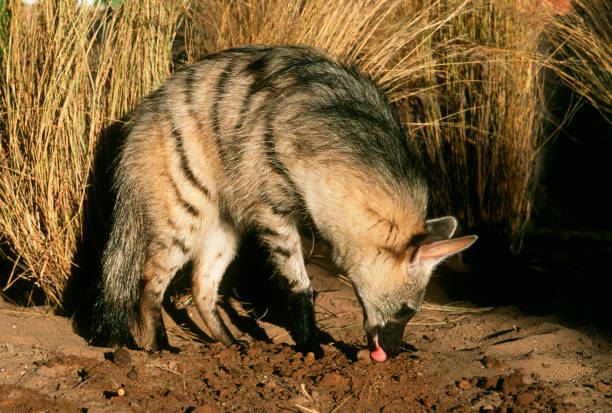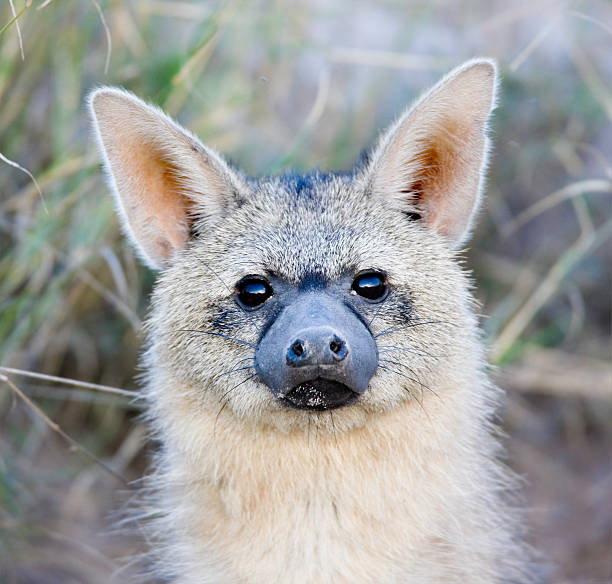Table of Contents
Scientific Classification
| Rank | Classification |
| Kingdom | Animalia |
| Phylum | Chordata |
| Class | Mammalia |
| Order | Carnivora |
| Family | Hyaenidae |
| Genus | Proteles |
| Species | Proteles cristata |
| Scientific Name | Proteles cristata |
Description
The aardwolf (Proteles cristata) is a fascinating member of the hyena family, distinct from its larger, more aggressive relatives. Unlike the spotted and striped hyenas, the aardwolf has a unique diet, primarily feeding on termites. While other hyenas are known for scavenging and hunting, the aardwolf’s name, which means “earth wolf” in Afrikaans, reflects its burrowing habits and nocturnal lifestyle.
Aardwolves possess a slender body, long legs, and a bushy tail. Their fur ranges from yellowish to light brown, adorned with dark vertical stripes that create a striking look. They also feature a thick mane along their back that can be raised when they feel threatened. Typically, an aardwolf measures 55–80 cm (22–31 inches) in length, excluding its tail, and weighs between 7–10 kg (15–22 lbs).

Distribution
Aardwolves are indigenous to Africa and can be found in two primary areas: Eastern and northeastern Africa, which includes countries like Kenya, Ethiopia, and Somalia, as well as Southern Africa, covering Namibia, Botswana, Zimbabwe, and South Africa.
These regions are warm and dry. They suit the aardwolf’s needs for food and shelter.
Habitat
Aardwolves thrive in open, dry areas such as:
- Grasslands
- Savannas
- Semi-arid plains
They avoid dense forests and extreme deserts. They prefer places with many termites. They often take shelter in burrows. They either dig their own or occupy abandoned ones left by aardvarks.
Diet
Unlike other hyenas, the aardwolf does not scavenge or hunt.. Instead, it has a specialized diet. It consists almost entirely of termites, mainly those from the Trinervitermes genus. A single aardwolf can consume up to 300,000 termites in one night using its long, sticky tongue.
They rely on termites, which means they don’t hunt larger animals. This makes them unique in the Hyaenidae family. The aardwolf’s teeth are small and weak, unlike other hyenas. They are not needed for crushing bones or tearing flesh.
Behavior
Aardwolves are solitary or live in monogamous pairs. They are different from larger hyenas. They aren’t aggressive and like to live a shy, nocturnal life.
- Nocturnal Activity – They forage at night, following termite trails by scent.
- Territorial Nature – They mark their territories using scent glands, warning off intruders.
- Defensive Posture – When threatened, an aardwolf lifts its mane to look bigger. It may also growl or bark.
- Minimal Vocalization – Aardwolves are quiet, unlike other hyenas. They mostly communicate by scent marking.

Lifespan
In the wild, aardwolves typically live for 8 to 10 years, while in captivity, they can survive for up to 15 years. Their lifespan is affected by factors such as food availability, environmental conditions, and the risks of predation.
Reproduction and Lifecycle
Aardwolves mate once a year, usually during the rainy season when termites are plentiful.
- Gestation Period – Around 90 days.
- Litter Size – Typically two to four cubs are born in underground burrows.
- Parental Care – Both parents take turns guarding and caring for their young.
- Weaning – Cubs start eating termites at three months and become independent at one year.
Predators
Aardwolves are rarely hunted by large predators. They are nocturnal and secretive. However, they do face threats from:
- Lions and leopards – Occasionally prey on aardwolves if they are found out in the open.
- Jackals and hyenas – May attack young or weak aardwolves.
- Humans – Sometimes killed due to mistaken identity, as they resemble other hyena species.
Aardwolves evade predators by using their speed and ability to burrow. Their cryptic coloration helps them blend into the dry grasslands.

Adaptations
Aardwolves have several adaptations that help them thrive in their special environment:
- Specialized Tongue – Coated with sticky saliva to pick up termites efficiently.
- Weak Teeth – Their teeth are weak. They don’t chew bones or flesh, so their teeth have adapted to an insectivorous diet.
- Keen Sense of Smell – Helps locate termite mounds even in the dark.
- Mane Erection – Can puff up their mane to look bigger and scare threats.
- Efficient Digestion – Their digestive system extracts nutrients from their diet of termites.
Conservation Status
The IUCN classifies the aardwolf as Least Concern. While their populations are stable, they face some threats:
- Habitat Loss – Due to agricultural expansion and urbanization.
- Poisoning – Some farmers mistakenly kill aardwolves, thinking they harm livestock.
- Climate Change – Altered weather patterns could impact termite populations, affecting aardwolf food supply.
Aardwolves are found in many protected areas and national parks. This helps to safeguard their future.
Conclusion
The aardwolf is an extraordinary creature. It is distinct from its carnivorous hyena relatives. It has an insectivorous diet and a timid nature. This shy “earth wolf” has fascinating adaptations and a nocturnal lifestyle. It plays a key role in controlling termite populations and balancing its ecosystem. The aardwolf is not well known. But, it is vital to Africa’s wildlife. It deserves our admiration and protection.




